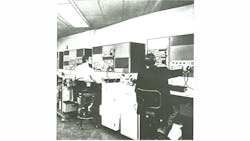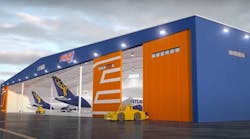I was deeply honored when asked to write this article for AMT magazine’s 25-year anniversary. As I thought about the subject, I was excited to take a trip back in time, looking at how it was then and how it is now. This trip opened my eyes at just how far we have come as an industry, how far each maintenance technician has come, and how much further we have to go.
Technology
Let’s start with the obvious – clearly we have come farthest when it comes to the technology of aircraft, the technology of maintenance tools and systems, and of our day-to-day lives. Moving from analog to digital has taken us longer than the video game industry. In fact, aircraft with analog technology still pepper the skies. For us techs, the transition has been a newfound skill for some, and very painful for others.
Troubleshooting newer aircraft now rarely requires a box of tools. It requires a tech to strap on a computer. When the transition began, it was hard to find techs that wanted to move to this phenomenon. Change in those days was hard to instill and even harder to manage. There was always the handful of techs that understood the technology, embraced it, and were called upon to save the day. They traveled around the clock, perfected their skills, and mentored the newer techs in the art.
Today, the transition is almost complete. I say almost, because technology is growing and changing like a snowball rolling downhill. Who would have thought back then, that we would now be finding our trouble-shooting schemes in “the cloud,” or that the airplane itself would phone home in flight to tell us what’s wrong with it, so we could be ready to repair when it landed.
MSG 3 has also changed how we maintain our fleets. We have safely taken out thousands of hours of maintenance from the planned events. We like to say maintenance begets maintenance, so many times, the less we touch an aircraft the better. It’s an approach that we can apply forward, for new models, or even backward, as we have at Bombardier through our Challenger 300 and Challenger 605 MAX Programs, evolving maintenance programs, optimizing the number of tasks and more. Less risk, reduction of redundancy, and most importantly, less cost – and the bottom line has certainly risen as a priority these past decades.
Costs: Seeing the airplane as a tool
Time is money. This has always been the central theme for airline maintenance. The aircraft is not making money on the ground. In a world where cost is measured by the seat and mile, airlines are very cognizant of cost of parts, and tuned in to turn times. Little has changed in that respect but technology and lean operations have helped continue to refine the balance of speed, safety, and price.
On the other side of our industry, in the corporate aviation world, the maintenance event was what it was 25 years ago – largely driven by headcount and work backlog. The corporate operator was forced to accept any downtime quoted.
Today, in the corporate world, time can take precedence over cost. Cost remains of paramount importance – don’t get me wrong – but the principal, and their staff, needs to be in more places on a day-by-day, hour-by-hour basis to meet their business objectives. Downtime can be much more expensive than a typical technician may realize. In many cases, the cost of lost opportunities from not having the aircraft flying can be much more expensive than any discount that a maintenance provider may offer. It is important for our AMTs to understand this, and be in tune with each operator’s business. Twenty-five years ago, this wasn’t a part of our toolboxes, but more and more, we’re literally thinking outside the box.
The Business Acumen Evolution of AMTs
In the past, turn times and the cost of being down weren’t part of a technician’s day-to-day customer satisfaction levers. They only needed to “fix the airplane.” Technicians were seldom included in the financial knowledge piece of the business. But as we all know, knowledge is power, and if we empower our technicians with that knowledge, they can help.
In our world today, maintenance providers and their AMTs need to have more of a sense of the cost of time of each operator, not just their own. Most people in our world aim to please. We aim to help make others be successful. I truly believe that! But we do not help others if we do not know why, or how.
Throughout Bombardier’s service centre network, we logged 70,000 man hours of training last year. We will exceed that number this year. I am sure many other MROs train in a very robust manner, but do we train the folks in the world of business acumen? Do they understand the pressures of their customer? Do the airlines teach them the importance of turn time from a financial point of view?
This should not be a call to rushing work, and affecting quality. Compromising quality and safety is never acceptable. Training technicians in these processes, and use of the technology is very important, but so is the learning and expansion of financial acumen. When you broaden a technician’s toolbox, these changes benefit your business but most importantly change how your build relationships with our operators, and change what you can offer their business.
The “pre-buy” inspection
I love this topic, and I must speak to it in the article, because this area has morphed from an innocuous piece of the aviation world, to an integral part of the industry, where the AMTs' financial skills can shine as much as their technical eye.
Back in the day, the pre-buy or “the survey” was leveraged in the used aircraft market. An MRO would “kick the tires,” look at the logbooks, and give a report to the buyer who would place an offer based on what was found vs. the market value - simple observation and subtraction.
Over time, the buyers, dealers, and brokers of the world started requiring risk mitigation. If discrepancies were not found at “pre-buy,” yet revealed itself shortly after purchase, the new owner was not happy. This required MROs to increase the intensity of the survey. Prices went up, but so did the intrusiveness of the examination.
Today, with menu pricing, lots of help from the customer base, and a better understanding of the need by the MRO community, the “pre-buy” has turned into an event that can make all participants happy. Again, the business side of the event needs to be understood by the techs, to ensure the contract between the maintenance team and the buyer is adhered to. No more than was asked for, and no less than was asked for.
It is very clear that the MRO is in a sticky position. To the seller, they are finding too many discrepancies from the survey, while the buyer wants to know everything possible for the least amount of money. Done well, the MRO can be in a great position to upsell the new owners with upgrades to the aircraft, bringing it into the more modern world of technology and aesthetics.
In the old days, the survey used to be problematic, but today, the “pre-buy inspection” is a source of income for a very large and thriving part of the industry, and a key opportunity to forge a profitable relationship with your airworthy business tool.
Where we can improve?
All in all, we follow technological trends but need to train our AMTs more in the financial parts of our industry, in all areas. I believe this needs to be introduced in the technical schools, and part of the growth of every MRO. Technology will change, new processes can be learned, but if we do not train ourselves on why embracing the change is important, we will not leverage all the talent we have to create a better product and industry.
25 years ago, we were less demanding as an industry, and we were less entrepreneurial. We can sit around waxing philosophically about the past, or we can look forward. Our millennials will not allow anything but, and if those of us who remember the good ol’ days are stuck looking back, those same millennials will run us over!
Stan Younger is vice president, Service Centres, Bombardier Business Aircraft. For more information visit customerservices.aero.bombardier.com.



